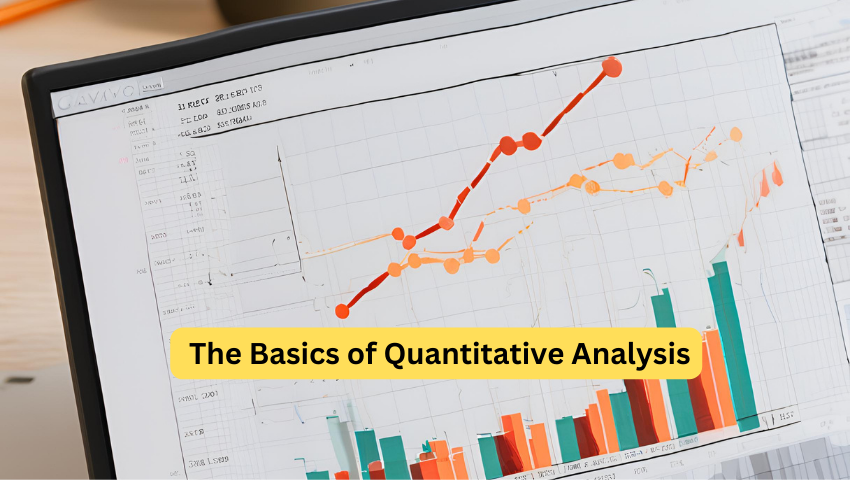
Quantitative analysis is a powerful tool used in financial markets to make informed decisions based on data and mathematical models. It involves the systematic study of numerical data to identify patterns, trends, and relationships that can be used to predict market behavior and optimize investment strategies. In this comprehensive guide, we will explore the fundamentals of quantitative analysis and its applications in financial markets.
Why Quantitative Analysis Matters in Financial Markets
Quantitative analysis plays a crucial role in financial markets for several reasons:
Data-Driven Decision Making: Quantitative analysis allows investors to make decisions based on empirical evidence rather than intuition or emotion.
Risk Management: By analyzing historical data and market trends, investors can identify and manage potential risks in their investment portfolios.
Portfolio Optimization: Quantitative models can be used to construct optimal investment portfolios that maximize returns for a given level of risk.
Algorithmic Trading: Quantitative analysis is used extensively in algorithmic trading, where automated trading strategies execute trades based on predefined rules and parameters.
Competitive Advantage: Firms that employ quantitative analysis often have a competitive advantage in the market, as they can quickly analyze large amounts of data and identify profitable trading opportunities.

Quantitative analysis is a fundamental aspect of financial markets, allowing investors to make data-driven decisions and optimize their investment strategies. In this section, we will explore the basics of quantitative analysis, including its definition, importance in financial markets, and common tools and techniques used.
Quantitative analysis plays a crucial role in financial markets for several reasons. First and foremost, it allows investors to make informed decisions based on empirical evidence rather than intuition or emotion. By analyzing historical market data and using mathematical models, investors can identify profitable trading opportunities, manage risk, and optimize their investment portfolios.
While qualitative analysis focuses on subjective factors such as management quality, industry trends, and competitive positioning, quantitative analysis focuses on objective numerical data. Quantitative analysts use mathematical models to analyze historical market data and predict future price movements, allowing investors to make data-driven decisions and optimize their investment strategies.
Quantitative analysts use a variety of tools and techniques to analyze financial data and make investment decisions. These may include statistical analysis, mathematical modeling, computer programming, and algorithmic trading. Some common tools and techniques used in quantitative analysis include:
By leveraging these tools and techniques, quantitative analysts can analyze large amounts of financial data, identify patterns and trends, and make informed investment decisions.
Key concepts in quantitative analysis provide the foundation for understanding and interpreting financial data. In this section, we will explore essential concepts such as statistical analysis, probability distributions, correlation and regression analysis, and time series analysis.
Statistical analysis is the process of collecting, organizing, analyzing, interpreting, and presenting data. It involves using mathematical techniques to describe and summarize data, make inferences about populations based on sample data, and test hypotheses. Some common statistical measures used in quantitative analysis include:
Statistical analysis provides valuable insights into the distribution, variability, and relationships within financial data, allowing investors to make informed decisions.
Probability distributions describe the likelihood of different outcomes in a random experiment. In quantitative analysis, probability distributions are used to model the uncertainty and variability of financial data. Some common probability distributions used in finance include:
Probability distributions provide a mathematical framework for modeling risk and uncertainty in financial markets, allowing investors to quantify and manage risk effectively.
Correlation and regression analysis are statistical techniques used to quantify the relationship between two or more variables. In finance, correlation analysis is used to measure the degree of association between the returns of different assets, while regression analysis is used to model the relationship between a dependent variable and one or more independent variables. Some key concepts in correlation and regression analysis include:
Correlation and regression analysis provide valuable insights into the relationships between financial variables, allowing investors to identify and exploit opportunities in the market.
Time series analysis is the process of analyzing and modeling sequential data points collected over time. In finance, time series analysis is used to analyze historical market data and make predictions about future price movements. Some common techniques used in time series analysis include:
Time series analysis provides valuable insights into the behavior of financial markets over time, allowing investors to make informed decisions and develop effective trading strategies.
Data collection and preparation are essential steps in quantitative analysis, ensuring that the data used for analysis is accurate, complete, and reliable. In this section, we will explore how to collect and prepare financial data for quantitative analysis, including sources of financial data, data cleaning and preprocessing, and handling missing data and outliers.
There are various sources of financial data that can be used for quantitative analysis, including:
By leveraging these sources of financial data, investors can access a wealth of information to inform their investment decisions.
Before conducting quantitative analysis, it is essential to clean and preprocess the data to ensure its quality and reliability. This may involve:
Data cleaning and preprocessing are critical steps in quantitative analysis, as they ensure that the data used for analysis is accurate and reliable.
Missing data and outliers can significantly impact the results of quantitative analysis, leading to biased or inaccurate conclusions. It is essential to handle missing data and outliers appropriately, using techniques such as:
By addressing missing data and outliers effectively, investors can ensure that their quantitative analysis is based on reliable and accurate data, leading to more informed investment decisions.

Building quantitative models is a key aspect of quantitative analysis in financial markets, allowing investors to analyze data and make predictions about future market behavior. In this section, we will explore how to build quantitative models for financial analysis, including selecting appropriate models, model validation and testing, and optimization techniques.
Quantitative analysts use a variety of modeling techniques to analyze financial data and make predictions about future market behavior. Some common modeling techniques used in quantitative analysis include:
By leveraging these modeling techniques, investors can analyze financial data and make informed decisions about their investment strategies.
When building quantitative models for financial analysis, it is essential to select appropriate models that are well-suited to the characteristics of the data and the objectives of the analysis. Factors to consider when selecting models include:
By selecting appropriate models, investors can ensure that their quantitative analysis is robust and reliable.
Once a quantitative model has been developed, it is essential to validate and test the model to ensure its accuracy and reliability. Model validation and testing involve:
By validating and testing the model, investors can gain confidence in its accuracy and reliability and make more informed decisions about its use in their investment strategies.
Optimization techniques are used to find the optimal solution to a problem, such as maximizing returns or minimizing risk. Common optimization techniques used in quantitative analysis include:
By leveraging optimization techniques, investors can optimize their investment strategies to achieve their objectives while minimizing risk.
Quantitative analysis finds numerous applications in financial markets, enabling investors to make informed decisions and optimize their investment strategies. In this section, we will delve into various applications of quantitative analysis, including stock market analysis, risk management, algorithmic trading, and asset allocation strategies.
Quantitative analysis is widely used in stock market analysis to predict stock price movements and identify profitable trading opportunities. Some common techniques used in stock market analysis include:
By leveraging quantitative analysis techniques, investors can gain insights into the behavior of stock prices and make informed decisions about their investment strategies.

Quantitative analysis plays a crucial role in risk management, allowing investors to identify, assess, and manage risks in their investment portfolios. Some common techniques used in risk management include:
By using quantitative analysis techniques, investors can quantify and manage risks effectively, ensuring the stability and resilience of their investment portfolios.

Quantitative analysis is widely used in algorithmic trading, where automated trading strategies execute trades based on predefined rules and parameters. Some common techniques used in algorithmic trading include:
By leveraging quantitative analysis techniques, algorithmic traders can exploit market inefficiencies and generate alpha, or excess returns, in the financial markets.
Quantitative analysis is also used in asset allocation strategies, where investors allocate their investment capital across different asset classes, such as stocks, bonds, and commodities, to achieve their investment objectives. Some common asset allocation strategies include:
By using quantitative analysis techniques, investors can optimize their asset allocation strategies to achieve their investment objectives while minimizing risk.

Looking ahead, several trends and innovations are shaping the future of quantitative analysis in financial markets. These include advancements in quantitative techniques, such as machine learning and artificial intelligence, the increasing availability of big data and alternative data sources, and the growing importance of environmental, social, and governance (ESG) factors in investment decision-making.
Advancements in quantitative techniques, such as machine learning and artificial intelligence, are revolutionizing the field of quantitative analysis. These techniques allow investors to analyze vast amounts of data quickly and efficiently, identify complex patterns and relationships, and make more accurate predictions about market behavior.
The proliferation of big data and alternative data sources is providing investors with new opportunities to gain insights into market behavior. By analyzing non-traditional data sources, such as social media sentiment, satellite imagery, and credit card transactions, investors can uncover hidden patterns and trends that may not be captured by traditional financial data.
There is growing recognition of the importance of environmental, social, and governance (ESG) factors in investment decision-making. Quantitative analysis techniques can be used to incorporate ESG considerations into investment strategies, allowing investors to align their investment decisions with their values and objectives.
Overall, the future of quantitative analysis in financial markets is bright, with advancements in technology, data availability, and ESG considerations driving innovation and change.
In conclusion, quantitative analysis is a powerful tool that plays a crucial role in financial markets, enabling investors to make informed decisions, manage risks, and optimize their investment strategies. Throughout this comprehensive guide, we have explored the fundamentals of quantitative analysis, including key concepts such as statistical analysis, probability distributions, correlation and regression analysis, and time series analysis.
We have also examined the applications of quantitative analysis in financial markets, including stock market analysis, risk management, algorithmic trading, and asset allocation strategies. By leveraging quantitative analysis techniques, investors can gain valuable insights into market behavior, identify profitable trading opportunities, and achieve their investment objectives.
However, it is essential to be aware of the challenges and limitations of quantitative analysis, such as overfitting and data mining bias, model complexity vs. interpretability, market dynamics and uncertainty, and regulatory and ethical considerations. Despite these challenges, quantitative analysis remains a valuable tool for investors, providing valuable insights into market behavior and helping investors make informed decisions.
Looking ahead, several trends and innovations are shaping the future of quantitative analysis in financial markets, including advancements in quantitative techniques, the increasing availability of big data and alternative data sources, and the growing importance of environmental, social, and governance (ESG) factors in investment decision-making.
In summary, quantitative analysis is an indispensable tool for investors in financial markets, providing valuable insights, identifying opportunities, and helping investors navigate the complexities of the financial world. By understanding the principles of quantitative analysis and staying abreast of developments in the field, investors can enhance their investment strategies and achieve their financial goals.